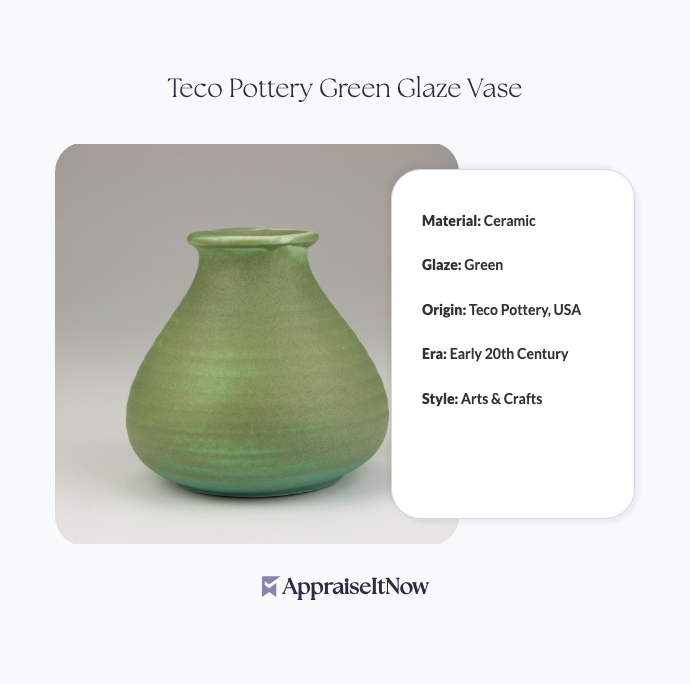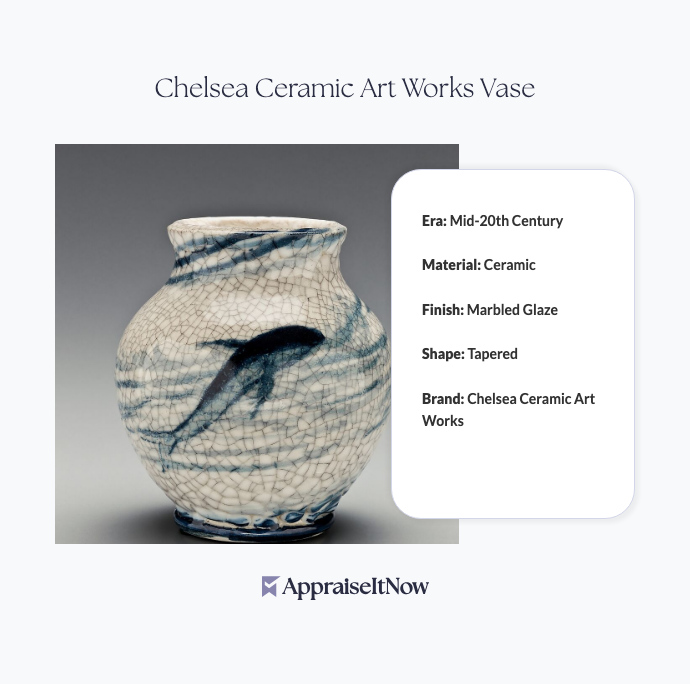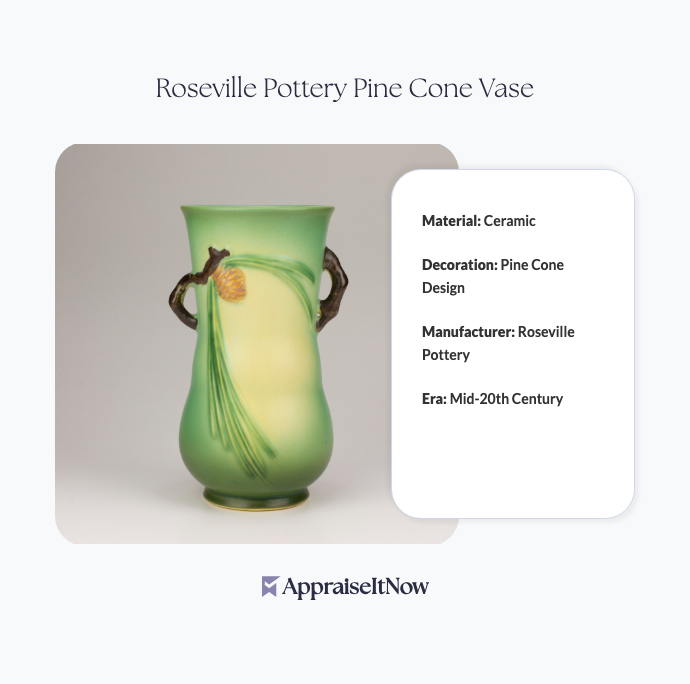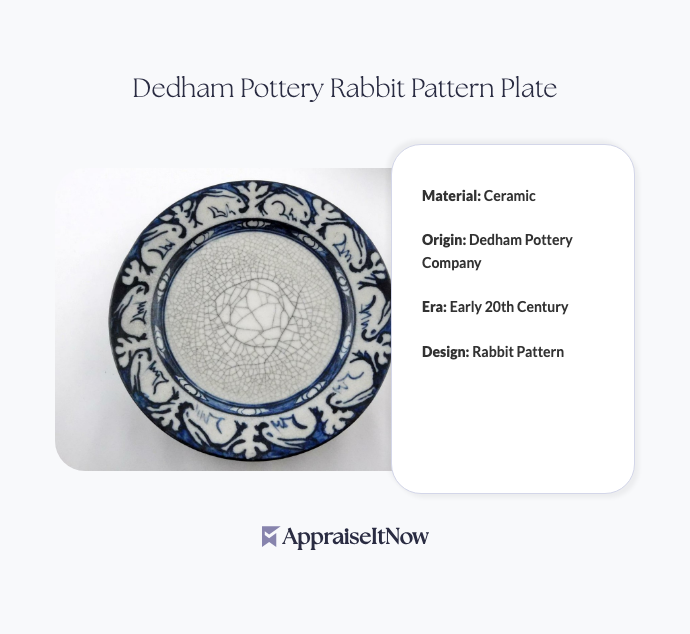<h1>How to Get Your Teco Pottery Green Glaze Vase Appraised</h1>
<p>If you own a Teco Pottery green glaze vase or are considering purchasing one, understanding how to get it properly appraised is essential for accurate valuation. A <strong>Teco Pottery green glaze vase typically values between $500 and $800</strong>, making it a significant piece of American Arts & Crafts heritage worth documenting and protecting through professional assessment.</p>
<h2>Understanding What You Own</h2>
<p>Teco Pottery represents one of the most respected ceramic traditions in American decorative arts. Established in Terra Cotta, Illinois, Teco (derived from the company's location) became synonymous with sophisticated Arts & Crafts design from 1905 onward. Your green glaze vase isn't merely functional ceramics—it's an investment piece and historical artifact that collectors and interior designers actively seek.</p>
<div class="callout tip"><p><strong>Collector's Insight</strong></p>
<p>Teco pieces with their signature earthy green glaze command consistent market demand, particularly when accompanied by clear provenance documentation.</p></div>
<p>The question "what is teco pottery?" frequently arises among collectors new to the Arts & Crafts movement. Teco Pottery, founded in 1905, gained prominence for its handcrafted designs featuring organic forms and rich matte glazes. Your green glaze vase exemplifies this aesthetic—the asymmetrical form and subtle glaze variations that collectors prize represent the hallmark of Teco's commitment to artistic integrity. Understanding this context directly affects how appraisers evaluate your piece and what methods they employ to establish fair market value.</p>
<h2>Key Characteristics That Appraisers Evaluate</h2>
<p>When securing a professional appraisal for your Teco Pottery vase, appraisers examine specific features that determine whether your piece falls at the lower end ($500) or upper tier ($800) of the valuation range. Each element contributes to the overall assessment, and knowing what appraisers scrutinize helps you prepare documentation.</p>
<p><strong>Form and Design Quality</strong> matter significantly. Teco's signature asymmetrical forms represent intentional artistic choices rather than production inconsistencies. Appraisers assess whether your vase demonstrates the organic, hand-thrown characteristics that distinguish Teco from mass-produced contemporaries. <strong>Glaze Integrity</strong> becomes another critical factor—the signature green glaze should display rich, earthy tones with consistent application. Any crazing, flaking, or restoration attempts require documentation, as original condition commands premium valuations.</p>
<p><strong>Size and Proportion</strong> affect value proportionally. Larger vases with commanding presence typically appraise higher than diminutive examples, assuming comparable condition. <strong>Maker's Marks and Signatures</strong> add provenance weight. Original Teco impressions on the base help appraisers authenticate pieces and establish production dates, particularly valuable for connecting your vase to documented product lines from Teco's archival records.</p>
<h2>How to Identify Your Teco Pottery Vase</h2>
<p>Before seeking professional appraisal, you'll want to confidently identify your piece as genuine Teco. The question "how to identify teco pottery?" becomes important for establishing baseline authenticity before investing in formal assessment services.</p>
<p>Examine the base carefully. Authentic Teco pieces bear impressed or incised markings reading "TECO" or "TECO POTTERY." Some examples include additional potter's initials or pattern numbers that help specialists date your vase within Teco's production timeline. The clay body typically displays a distinctive greenish-gray tone characteristic of Teco's favored materials. Unlike mass-produced ceramics from the era, Teco pottery demonstrates uneven thickness suggesting hand-thrown origins—this variation, rather than indicating defects, actually confirms authenticity to trained appraisers.</p>
<p>The glaze itself tells a story. Original Teco green glaze exhibits matte rather than glossy finish, with subtle color variations from light sage to deeper forest tones. This inconsistency in coloration across the surface represents intentional artistic practice, not manufacturing error. Modern reproductions typically display uniform glazing, which experienced appraisers immediately recognize as non-authentic. If you're uncertain about your vase's origins, professional ceramics appraisers can perform non-destructive analysis to confirm Teco attribution.</p>
<h2>Finding a Qualified Appraisal Professional</h2>
<p>Not all appraisers possess expertise in Arts & Crafts ceramics or early 20th-century pottery. When seeking professional valuation for your Teco vase, look for specialists with documented experience in <a href="/blog/appraising-fine-porcelain-and-ceramics-valuing-delicate-artistry">appraising fine porcelain and ceramics</a>. AppraiseItNow connects clients with credentialed experts—including certified appraisers holding designations from AAA, ISA, ASA, CAGA, and AMEA—who specialize in decorative <a href="/types/antiques">antiques</a> and <a href="/types/household-goods">household goods</a> valuation.</p>
<p>Your appraiser should demonstrate specific knowledge of Teco Pottery's production methods, design evolution, and market trends. They should understand how Teco fits within broader Arts & Crafts movements and recognize which production periods command premium valuations. When interviewing potential appraisers, ask directly about their experience with Arts & Crafts ceramics and their familiarity with Teco's product lines.</p>
<div class="callout note"><p><strong>Professional Standards</strong></p>
<p>Certified appraisers follow USPAP (Uniform Standards of Professional Appraisal Practice) protocols, ensuring your appraisal withstands scrutiny for insurance, sale, or estate purposes.</p></div>
<h2>Documentation to Prepare Before Appraisal</h2>
<p>Gathering thorough documentation before your appraisal appointment accelerates the process and provides valuable context that can enhance your vase's assessed value. Compile high-quality photographs from multiple angles—particularly close-ups of the base markings, glaze details, and any notable features. If you possess purchase documentation, sales receipts, or previous appraisals, bring these records. Family provenance information—such as when or how the piece was acquired—adds significant weight to authentication and valuation discussions.</p>
<p>Measurements matter too. Record the vase's height, width at the widest point, and base dimensions. These specifications help appraisers access comparable sales data from auction house records and market databases. If you're uncertain about any restoration or repairs, disclose these proactively. Transparency about a vase's condition—including any chips, repairs, or professional restoration work—enables appraisers to adjust valuations appropriately while maintaining credibility in their final reports.</p>
<h2>Understanding Teco Pottery Market Dynamics</h2>
<p>The secondary market for Teco pottery demonstrates steady, reliable demand among collectors. Unlike volatile luxury markets, Arts & Crafts ceramics maintain relatively stable valuations, making Teco pieces prudent for collection building. Your <strong>$500-$800 valuation range</strong> reflects current market conditions where quality examples with clear provenance command consistent interest.</p>
<p>Online auction records provide transparency into recent comparable sales. Major auction houses like Christie's and Sotheby's periodically feature Teco pottery, allowing serious collectors and appraisers to track market evolution. Small decorative vases typically realize prices at the lower end of Teco's range, while exceptional examples—particularly large-scale pieces or those with documented exhibition history—command substantial premiums. When you wonder "where was Teco Pottery made?", understanding that all pieces originated from Terra Cotta, Illinois adds geographic significance that collectors value.</p>
<h2>The Appraisal Report and What It Contains</h2>
<p>A professional appraisal of your Teco Pottery vase produces a comprehensive report suitable for insurance, sale, or legal purposes. This document describes your vase in technical detail, includes photographs, documents condition, and provides a certified valuation with supporting market analysis. The report includes the appraiser's credentials, methodology, and comparable sales data justifying the assessed value.</p>
<p>For insurance purposes specifically, ensure your appraisal explicitly states replacement cost value—the amount needed to acquire a similar piece at current market rates. This differs from market value assessment and becomes critical for coverage adequacy. Should you ever file a claim, insurers require current professional appraisals to process claims fairly. Our guide on <a href="/blog/tips-for-obtaining-accurate-personal-property-appraisals">tips for obtaining accurate personal property appraisals</a> offers additional guidance on insurance-specific documentation requirements.</p>
<h2>Determining Your Vase's Position Within the Value Range</h2>
<p>Several factors position your specific vase at either end of the $500-$800 spectrum. <strong>Exceptional condition</strong> with no chips, repairs, or glaze issues supports valuations approaching $800. <strong>Larger scale</strong> vases command premiums over petite examples. <strong>Documented provenance</strong>, particularly if your vase appeared in exhibitions or publications, significantly enhances value. <strong>Rare design elements</strong> or unusual glaze colorations can push valuations beyond standard ranges entirely.</p>
<p>Conversely, pieces requiring restoration, displaying visible wear, or lacking clear maker's marks typically appraise toward the lower range. This doesn't diminish their artistic or historical significance—it simply reflects market realities where condition directly impacts resale potential. Professional appraisers factor all these considerations systematically, explaining how they arrived at your vase's specific valuation within documented methodologies.</p>
<div class="callout tip"><p><strong>Value Consideration</strong></p>
<p>Even vases at the lower end of the range represent sound investments for Arts & Crafts enthusiasts, as Teco pottery has demonstrated consistent appreciation over decades.</p></div>
<h2>Why Professional Appraisal Matters for Teco Pottery</h2>
<p>You might wonder whether seeking professional appraisal justifies the cost for a vase valued at $500-$800. The answer depends on your circumstances. If you're planning to sell, insurance documentation provides essential protection against underinsurance. Estate planning requires certified valuations for equitable distribution among heirs. When consigning to auction houses, professional appraisals strengthen your negotiating position by establishing market-supported values. For collectors building comprehensive collections, professional documentation creates an asset inventory supporting estate, tax, and insurance planning.</p>
<p>Additionally, formal appraisals add credibility during resale. When you eventually offer your Teco vase to other collectors or dealers, professional certification demonstrates you've invested in proper authentication and valuation. This instills confidence in potential buyers and typically results in more favorable negotiating outcomes than unsubstantiated price claims.</p>
<h2>Exploring the Broader Arts & Crafts Market</h2>
<p>Understanding Teco Pottery's position within the larger Arts & Crafts marketplace provides context for your appraisal. Teco pieces represent American interpretation of Arts & Crafts ideals, distinct from European movements but equally respected by serious collectors. Our comprehensive resource on <a href="/blog/appraising-antiques-unveiling-the-hidden-treasures-in-your-collection">appraising antiques</a> explores how Arts & Crafts movements influence ceramics valuations across the collectibles landscape.</p>
<p>The movement's emphasis on handcraftsmanship, natural materials, and artistic integrity—core principles embodied in your Teco vase—continues resonating with contemporary collectors seeking authenticity and historical connection. This sustained interest supports stable valuations and provides reasonable confidence that your vase will retain or appreciate in value over time, making it an attractive addition to personal collections or investment portfolios.</p>
<hr />
<div class="callout note"><p><strong>Key Takeaway</strong></p>
<p>A certified professional appraisal of your Teco Pottery green glaze vase—valued between $500 and $800—provides essential documentation for insurance, sale, or collection management purposes. By understanding what appraisers evaluate, preparing thorough documentation, and working with specialists experienced in Arts & Crafts ceramics, you ensure accurate valuation and confident decision-making about your piece. AppraiseItNow's network of credentialed experts delivers USPAP-compliant assessments that protect your investment and provide the professional authentication your Teco pottery deserves.</p></div>







.avif)







